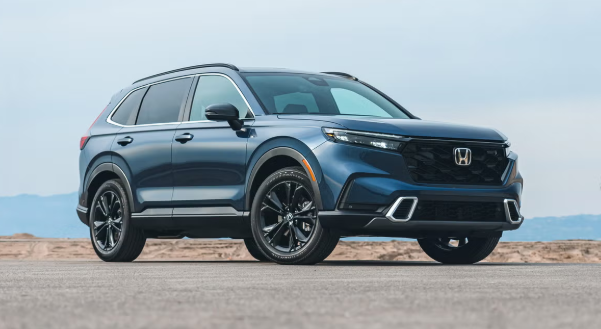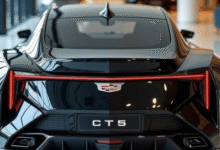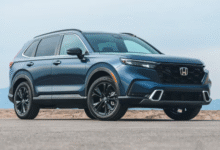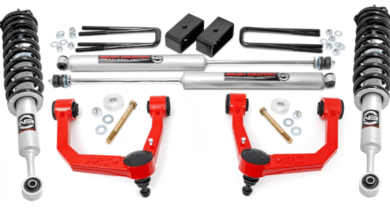Honda CR V 2024: Full Review, Features, Specs, and Buying Guide

The honda cr v 2024 is the latest iteration of Honda’s popular compact crossover SUV. Now in its sixth generation, the 2024 CR-V brings refreshed styling, upgraded interior technology, more efficient powertrain options, and safety features intended to maintain its competitiveness in a crowded segment. Over the years, the CR-V has built a reputation for reliability, versatility, and strong resale value — and the 2024 model aims to continue that tradition.
In this article, we will examine the design, performance, interior features, safety systems, and market positioning of the 2024 CR-V. At the end, you’ll find a conclusion and a set of frequently asked questions (FAQs) to help readers understand whether the CR-V 2024 is a good fit for them.
Design & Exterior
The 2024 CR-V retains the overall proportions of the sixth-generation platform but introduces subtle refinements to its styling. Honda has stretched the wheelbase slightly and moved the A-pillars rearward, giving the CR-V a longer, more balanced profile. The front end is more sculpted, with a sharper grille, slimmer LED headlights, and revised bumper lines for a cleaner, more modern appearance. At the rear, vertical-style tail lamps remain a CR-V signature, but their internal design and light signatures have been updated for a more premium look.
Honda offers alloy wheel options (typically 18″ and 19″ sizes), and in many markets, trim levels will dictate whether features like roof rails, gloss-black accents, and sporty body cladding are included. For hybrid variants, more aerodynamic touches (such as lower front fascia elements and optimized underbody panels) help with efficiency.
In terms of dimensions, the 2024 CR-V is slightly larger than its predecessor. The longer wheelbase gives more rear-seat legroom, and the overall vehicle length has grown modestly.
Powertrains & Performance
One of the defining aspects of the 2024 CR-V is the availability of two primary powertrain options: a turbocharged gasoline engine and a hybrid system.
Gasoline (Turbo) Option
For the non-hybrid variants, Honda uses a 1.5-liter turbocharged four-cylinder engine. This setup produces around 190 horsepower and about 179 lb-ft of torque. The engine is mated to a continuously variable transmission (CVT), and buyers may choose between front-wheel drive (FWD) or all-wheel drive (AWD) depending on the trim.
Performance is decent but not sporty — expect 0–60 mph (0–96 km/h) times in the ballpark of 8–9 seconds in properly equipped models. Under heavy acceleration, the CVT can cause the engine to drone, which is a common criticism in this class.
In terms of fuel efficiency, the turbo non-hybrid CR-V delivers respectable numbers. EPA estimates for U.S. models are about 28 mpg city / 34 mpg highway for the FWD version; opting for AWD drops those slightly. In real-world tests, a CR-V AWD registered ~31 mpg on highway driving.
Hybrid Option
For buyers who prioritize fuel economy, the hybrid variant is compelling. The hybrid system pairs a 2.0-liter Atkinson-cycle gasoline engine with electric motors to deliver combined outputs that approach 204 horsepower in many markets.
Fuel economy for the hybrid version is significantly improved. For example, in the U.S., combined ratings are in the range of ~40 mpg (or better) depending on FWD vs AWD and driving conditions. Because the hybrid variant uses electric assist, acceleration can feel more responsive especially in city driving. However, it is also more complex, with additional systems to maintain (battery, motor controllers, etc.).
One tradeoff is that the hybrid variant often costs more up front and in some markets may come only in higher trim levels.
Interior, Comfort & Technology
Honda has paid attention to the CR-V’s cabin experience, aiming for durability, comfort, and functional design.
Seating & Space
The 2024 CR-V seats five occupants in most versions. In some markets, the gasoline trims might even offer a seven-seat option (with a third row) depending on region-specific configurations. Thanks to the longer wheelbase and revised layout, the rear seats gain more legroom and a bit more recline adjustment (up to about 10.5° in some configurations). Headroom and shoulder room are generally generous for a compact SUV.
Cargo space is competitive, and the CR-V retains a functional rear cargo area with folding rear seats to expand capacity when needed.
Materials & Layout
Interior materials are a mix of soft-touch surfaces, durable plastics, and trim-specific accents (e.g. metallic or gloss black elements). Higher trims may feature leather upholstery, contrast stitching, and additional soft padding.
The dashboard layout is clean and horizontal, aiming for clarity and ease of reach. Ventilation outlets, climate control knobs/controls, and infotainment display are all arranged intuitively.
Infotainment & Connectivity
Each 2024 CR-V comes equipped with modern connectivity: Apple CarPlay and Android Auto are standard or available (often wirelessly in higher trims). The size of the touchscreen and feature list vary by trim — higher trims might offer larger displays, premium audio, navigation, wireless charging, and additional USB ports.
One recurring criticism among owners, however, is that some infotainment functions feel laggy or less polished, and some features (e.g. wireless charger) require precise placement of devices to work well.
Other conveniences include features like power tailgate, keyless entry and start, multi-zone climate control, and advanced driver-assist displays. In higher trims, things like ambient lighting, heated/ventilated seats, and upgraded cabin features are more likely to appear.
Safety & Driver Assistance
Safety has long been a strong selling point for the CR-V, and Honda continues to include a host of driver-assist features under its Honda Sensing® suite Key features include:
- Forward Collision Warning with Automatic Emergency Braking
- Lane Keeping Assist / Lane Departure Warning
- Adaptive Cruise Control
- Traffic Sign Recognition
- Blind Spot Monitoring / Rear Cross Traffic Alert (in many trims)
- Collision Mitigation Braking System
Additionally, the CR-V’s body structure, crashworthiness, and standard safety systems (airbags, structural reinforcements) aim to score well in regulatory crash tests.
In some markets, hybrid and RS trims receive additional advanced safety tuning or extra features. For example, the CR-V RS is often the top-tier hybrid variant and includes more features as standard.
That said, no vehicle is perfect. Some driver reviews note missing features in top trims that they expected (e.g. lack of a 360° camera in some versions) and critiques of auxiliary systems (wipers, etc.).
Driving Experience & Ride Quality
One of the CR-V’s strengths is that it achieves a good balance between everyday comfort and composed handling.
The suspension tuning is oriented toward comfort. Road imperfections, bumps, and uneven surfaces are absorbed relatively well, with minimal harshness transferring into the cabin. Steering feel is generally light and confidence-inspiring at typical driving speeds.
On twisty roads, the CR-V holds its own, though it’s not a sports SUV. Body roll is controlled but present, and one should not expect sharp, aggressive handling. The hybrid variants, due to increased weight and different torque delivery, may feel slightly less agile than their gasoline counterparts in tight maneuvers, but they often make up for it with smoother low-speed performance.
Noise, vibration, and harshness (NVH) levels are well managed for the class, though under high load or high RPM the turbo engine (especially in non-hybrid variants) can become more audible.
All in all, the CR-V is comfortable and predictable — ideal for daily commuting, family use, and light highway duty.
Market Positioning & Value
In the compact crossover/SUV segment, competition is fierce. The CR-V competes with models such as the Mazda CX-50, Toyota RAV4, Hyundai Tucson, Nissan Rogue (X-Trail), and others. What keeps the CR-V attractive in this field is its reputation for reliability, resale value, balanced feature set, and the option of a hybrid for those seeking better fuel economy.
In terms of pricing, Honda positions the CR-V in the mid to upper range of its class, especially for hybrid or higher trims with more premium features. Many reviewers suggest that for most buyers, a mid-tier trim (with a mix of comfort, features, and value) offers the sweet spot.
One risk is that some features expected in high-end trims may still be omitted in certain markets, and that the hybrid variant’s added complexity may lead to slightly higher maintenance (though Honda’s hybrid systems have proven fairly reliable).
Conclusion
The 2024 Honda CR-V is a well-rounded compact crossover that builds on the strengths Honda has developed over decades. Its refreshed styling, modern interior features, two viable powertrains (turbo and hybrid), and robust safety suite make it a strong contender in its class. While it is not the most thrilling in terms of performance, it delivers exactly what many SUV buyers want: comfort, space, efficiency, and reliability.
For buyers who do more urban driving or value fuel economy, the hybrid version is a compelling choice. For those who prefer less complexity and lower up-front cost, the turbo variant is still very capable. The bottom line is that the 2024 CR-V remains a solid, dependable option in the compact SUV segment.
FAQs
Q1: What are the engine options for the 2024 CR-V?
A: There are primarily two options: a 1.5 L turbocharged 4-cylinder engine (about 190 hp) for non-hybrid trims, and a hybrid system combining a 2.0 L Atkinson-cycle engine with electric motors (total system output near ~204 hp in many markets).
Q2: What is the fuel economy of the 2024 CR-V?
A: For the non-hybrid model, EPA estimates are ~28 mpg city / 34 mpg highway (for FWD; AWD is slightly lower). The hybrid versions typically achieve significantly higher combined figures (often in or around 40 mpg, depending on configuration and driving conditions).
Q3: Does the 2024 CR-V come with all-wheel drive (AWD)?
A: Yes, many trims offer AWD (or what Honda terms Real-Time AWD), especially in markets or trims where extra traction is valued. However, some base or economy trims might come with FWD only.





